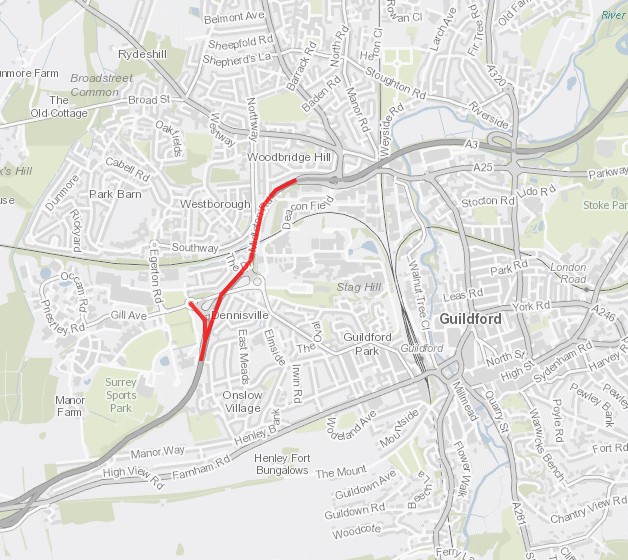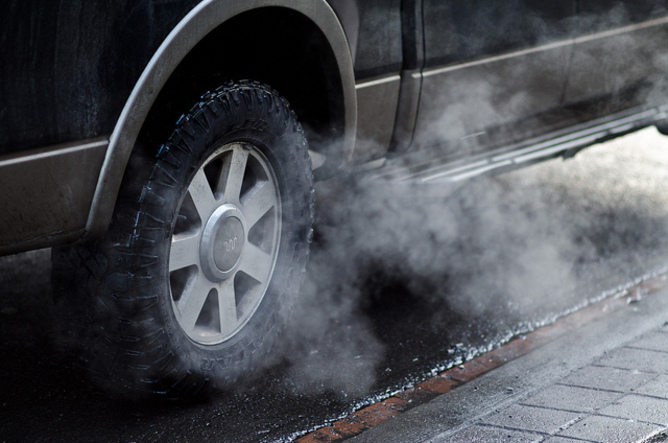 Abraham Lincoln
If given the truth, the people can be depended upon to meet any national crisis...
Abraham Lincoln
If given the truth, the people can be depended upon to meet any national crisis...
 Guildford news...
for Guildford people, brought to you by Guildford reporters - Guildford's own news service
Guildford news...
for Guildford people, brought to you by Guildford reporters - Guildford's own news service
A3 Guildford Pollution Worst in England, GBC Leader Blames ‘Infrastructure Deficit’
Published on: 24 Jul, 2021
Updated on: 24 Jul, 2021

NO2 modelled at 89 μg/m3 (micrograms per cubic meter of air) in 2020 on the A3 through Guildford. The Air Quality Standards Regulations 2010 require that the annual mean concentration of NO2 must not exceed 40 μg/m3.
By Hugh Coakley
“Decades of failure to address the infrastructure deficit in our borough, is potentially leading to poor health outcomes for our residents due to exposure to NO2” said GBC leader Joss Bigmore following the Highways England announcement that the A3 through Guildford has the worst nitrogen dioxide (NO2) pollution in the country.
The pollution, directly affecting Park Barn, Westborough and Dennisville and parts of Onslow Village, is already more than double the national air quality limits and will continue to exceed them until at least 2030. It is over 20% higher than other identified affected hotspots in Oxford, Derby and the A282 extension to the M25.
Highways England, which manages the strategic road network, including the A3, are considering traffic management measures and a 9.5m high barrier along the sides of the A3 to shield those closest to the road from the fumes. But an air quality barrier would have less than 10% improvement on pollution levels says the report.
 Other ways of reducing the pollution, including bus and HGV retrofits, electric van introduction and speed management, have all been ruled out by HE
Other ways of reducing the pollution, including bus and HGV retrofits, electric van introduction and speed management, have all been ruled out by HE
Air quality expert, Professor Prashant Kumar from the University of Surrey and founder of the Global Centre for Clean Air Research, offered possible reasons why the A3 in Guildford could be faring so badly saying it could be due to the “heavy traffic volume, congestion, idling, and stop-start of vehicles – all these add disproportionally to the usual levels and make this stretch [of the A3] distinct”.
The HE report says that “poor air quality is the largest environmental risk to public health in the UK”, affecting vulnerable groups such as the elderly, children and those suffering from pre-existing health conditions.
Describing the effects Professor Kumar said they “can start from worsening pre-existing health conditions such as a cough, wheezing, asthma attacks to reduced lung function and increased probability of emergency hospital admissions.
“Emissions from road vehicles decay exponentially away from the road. It can take 100s of meters to reach usual background levels, depending on the built-up environment surrounding the road. It means the people living nearby may get disproportionally higher exposure.”
Mark Bray-Parry, spokesperson for the Guildford Green Party, said he was “unsurprised” by the results and it was “essential that we look at other options” to reduce the pollution. With 90% of NO2 road vehicle emissions attributed to diesel vehicles, we needed “to encourage transport away from diesel” through incentivising electric cars, public transport and rail, particularly for freight.
“One option would be to create a low emissions zone through Guildford along with a Park & Ride to the north and south of the zone. This might encourage freight to move to the M3 or M23 to access the south coast while an accessible Park & Ride, with regular, subsidised bus services, would try to alleviate some of the 50% of traffic across the A3 that stops at Guildford.”

Traffic jams are common on the A3 around Guildford and worsen the traffic pollution. Library image of northbound traffic at Burpham.
Ramsey Nagaty (Guildford Greenbelt Group, Shalford), lead for the Guildford Greenbelt Group, said that HGV traffic had increased since the Hindhead Tunnel was opened in 2011. He had reservations about using 9.5m barriers saying it may help residents but would “seriously affect” motorists in stationary traffic. He said we should consider hedges as potentially a better solution.
Deputy GBC leader, Jan Harwood (Lib Dem, Merrow) said: “The report presents some stark facts about air quality on the A3”. He said improving air quality was one of GBC’s highest priorities.
Regarding reducing the NO2 levels, he dismissed a tunnel solution, raised by Guildford’s MP Angela Richardson at Prime Minister’s Questions last week: “Re-routing the A3 via an underground tunnel is not a solution that is likely to come forward within a reasonable time, nor is it likely to be funded under the current government.
“The best long-term solution is to move to sustainable travel options including cleaner, low and zero-emission vehicles, and to persuade fleet operators who use the A3 to switch from diesel to electric vehicles.
“Everyone can do their bit by making some small changes to their lifestyle and daily routine: walking, cycling or using public transport more, and turning off your engine if you are stopped at a junction or outside a school for more than 10 seconds.”
The 1.5km stretch identified in the HE report is from the Woodbridge Road junction west of Ladymead to the junction with Egerton Road to the hospital, the Surrey Research Park and the supermarket, Tesco.
GBC has carried out a feasibility study on behalf of HE into traffic management options and a 9.5m high barrier to improve air quality along the affected length of road. The Dragon has asked for a copy of the study.
We have also invited comments from Guildford’s MP, Angela Richardson, Zoe Franklin (Lib Dem parliamentary candidate) and party political comment from R4GV, Conservative and Labour parties.
Responses to A3 Guildford Pollution Worst in England, GBC Leader Blames ‘Infrastructure Deficit’
Leave a Comment Cancel reply
Please see our comments policy. All comments are moderated and may take time to appear. Full names, or at least initial and surname, must be given.
Click on cartoon for Dragon story: Public Asked for Views on SCC’s Proposal for Reduced Speed Limits



Recent Articles
- GuilFest Returns to Stoke Park with Global Names and Local Soul
- Exercise May Aid Body’s Immune Response Against Cancer, Pilot Study Finds
- Letter: How Surveys of Public Opinion Should Be Organised
- Catapult Attacks, Shoplifting and Graffiti – the ASB Problem That Ash Is Facing
- A281 Closure Expected to Continue
- Guildford’s Green Day Shows Commitment to Net Zero by 2030 Remains
- Letter: We Should All Have a Say in How Our Local Government Is Reorganised
- Dragon Review: Madam Butterfly – Grange Park Opera
- Letter: PIP Claimants Under-claim
- Flashback: Council Report Accepts Juneja Case Has Caused ‘Reputational Damage’


Recent Comments
- Roger Kendall on Catapult Attacks, Shoplifting and Graffiti – the ASB Problem That Ash Is Facing
- Anthony Williams on A281 Closure Expected to Continue
- Jules Cranwell on Flashback: Council Report Accepts Juneja Case Has Caused ‘Reputational Damage’
- Tony Harrison on Letter: Reduced Speed Limits Will Save Lives
- Tony Harrison on A281 Closure Expected to Continue
- Helena Townsend on Letter: Not All PIP Claimants Need It
Search in Site
Media Gallery
Dragon Interview: Local Artist Leaves Her Mark At One of England’s Most Historic Buildings
January 21, 2023 / No Comment / Read MoreDragon Interview: Lib Dem Planning Chair: ‘Current Policy Doesn’t Work for Local People’
January 19, 2023 / No Comment / Read MoreA3 Tunnel in Guildford ‘Necessary’ for New Homes, Says Guildford’s MP
January 10, 2023 / No Comment / Read More‘Madness’ for London Road Scheme to Go Ahead Against ‘Huge Opposition’, Says SCC Leader
January 6, 2023 / No Comment / Read MoreCouncillor’s Son Starts Campaign for More Consultation on North Street Plan
December 30, 2022 / No Comment / Read MoreCounty Council Climbs Down Over London Road Works – Further ‘Engagement’ Period Announced
December 14, 2022 / No Comment / Read MoreDragon Interview: GBC Reaction to the Government’s Expected Decision to Relax Housing Targets
December 7, 2022 / No Comment / Read MoreHow Can Our Town Centre Businesses Recover? Watch the Shop Front Debate
May 18, 2020 / No Comment / Read More










Sam Peters
July 24, 2021 at 2:38 pm
Unfortunately, I am not remotely surprised by this either. When I tested NO2 for Friends of the Earth in 2016 at Ladymead, I found levels at nearly 150% of the legal maximum, a limit still significantly higher than the WHO [World Health Organisation] recommends. And the situation will only have worsened since then.
As others have said in the article, we need a rapid transition to active travel and accessible, affordable public transport, not just to tackle air pollution but also the climate crisis, public health impacts and more. An A3 tunnel cannot solve these problems, but even if it could, the timescales simply don’t match the urgency required.
Sam Peters is a spokesperson for The Green Party
Mark Bray-Parry
July 24, 2021 at 3:04 pm
While I support hedging being installed in areas of high particulate pollution, unfortunately, Cllr Nagaty’s suggestion of hedging for the A3 won’t help since the issue is a gaseous pollutant, specifically NO2. Vegetation is, sadly, a poor sink for NO2.
I am pleased that Cllr Harwood emphasises the importance of individuals looking at their own travel but, since 50% of emissions are from HGVs, it is really important that we look at immediate solutions that will reduce HGV traffic through Guildford.
That is why a low emission zone through Guildford and including the highlighted section of the A3 to encourage freight onto motorways (eg M3 and M23) is a serious solution to protect the health of Guildford residents.
Alan Morris
July 25, 2021 at 7:57 am
So the A3 through Guildford has the notorious privilege of being the worst polluted stretch of trunk road in England, certainly not an award to be taken lightly, yet Highways England is only responsible for England’s motorways and major A-roads not the remainder of our local road network.
Let’s not forget as Mark Bray-Parry [Green Party spokesman] suggests all of those urban roads such as the Dennis Roundabout to Burpham stretch or the A320/A281 road through the centre of the town that, during the peak traffic hours must be suffering similar levels of traffic pollution. Such pollution is not generated solely by A3 traffic but by local commuters.
The idea of creating barriers just to address the findings of a Highways England report might, without careful consideration, prove to be counter-productive. I look forward to reading the GBC report.
Jules Cranwell
July 27, 2021 at 6:20 am
Surely this is another clear reason for a root and branch review of the Local Plan. Thousands of new homes means thousands more cars on our roads, especially the A3.
We have no choice but to cancel the Local Plan, and impose a moratorium on any more development.
The granting of planning permission for Manor Farm in West Horsley shows that GBC is not taking pollution, and its impact on our health seriously.
Bibhas Neogi
July 30, 2021 at 11:52 am
I wonder what plans, if any, Highways England has for the B3000 between the A3 and the A31. This stretch is heavily congested during peak periods and pollution also must be high.
The B3000 is a local road and it is the responsibility of Surrey County Council. However, the left turn from the northbound A3 on to the A31 was stopped up and the road was made one lane on-slip to the A3. The B3000 was then signed as the route to the A31 from the A3 by the Highways Agency.
Normally a connection between two A-type roads should also be at least of the standard required for an A-type road. B3000 is narrow and twisty and not really up to carrying the volume of traffic it does now. It has led to severe congestion especially after the Blackwater Valley A331 bypass connected the A31 with the M3.
The A3 widening should take this on board when dealing with its junction with the A31. A new route should be created either between Compton Interchange and the A31 or a new slip road should be built to connect the two roads.
This is long overdue and another reason to reinstate and progress the A3 widening scheme as a matter of urgency.